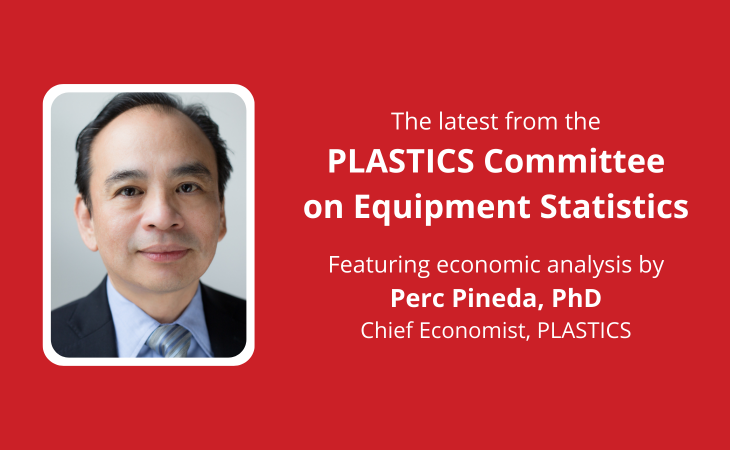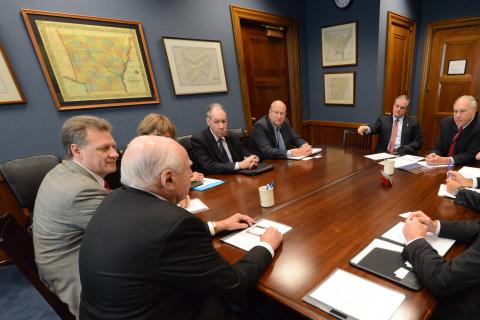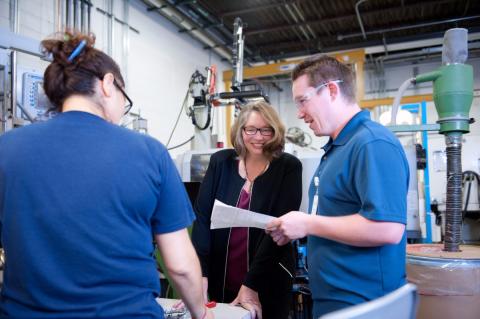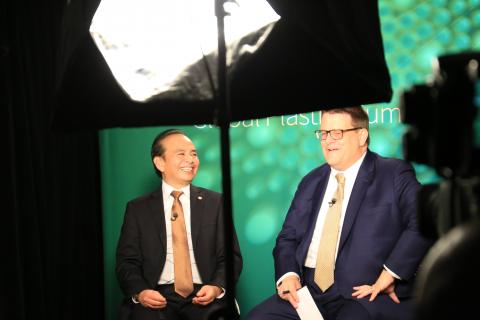Perc Pineda, PhD
Chief Economist
The market is currently anticipating a 25 basis point Fed funds rate hike at the June 14th Federal Open Market Committee meeting, with a 64.2% probability according to the CME FedWatch Tool. Despite some expectations for a possible pause from the Fed, the likelihood of another rate hike currently outweighs the probability of a pause. It is premature to speculate about a rate cut this year, considering the resilient state of the U.S. economy, despite existing market risks. Moreover, inflation remains elevated, with an increase observed in April.
Household and business prospects are mixed
In April, the Personal Consumption Expenditure (PCE) Index, including the core PCE, rose to 4.4% and 4.7% respectively. In March, PCE and core PCE inflation stood at 4.2% and 4.6%. Although the changes were not drastic, the fact that inflation is increasing rather than decreasing amidst the Fed's monetary policy tightening raises concerns.
The labor market remains robust, leading to positive effects on demand. The unemployment rate in April reached 3.4%, matching the lowest level seen in April 2000. It is not surprising that personal consumption expenditures experienced a 0.8% increase in April, amounting to a 6.7% year-on-year growth.
Although monthly supply-side data tends to be volatile, there have been significant developments worth noting, including a 2.2% increase in housing starts and a rise in motor vehicle assemblies to over 11.0 million units on an annualized basis. This follows a year of fluctuations between 9.5 million and 10.4 million units. However, it is important to consider that higher borrowing costs are likely to exert pressure on the housing and automobile sectors, suggesting that these recent increases may be temporary or transitory in nature.
Credit is harder to come by
However, the tightening of lending standards by banks for commercial and industrial loans, as well as for credit cards, has reached levels comparable to those seen during the past three recessions. Consequently, it is not surprising that the higher cost of capital aligns with the 4,063 businesses that sought bankruptcy protection in the first quarter, which represents an increase of 998 compared to the same period last year. These businesses face significant challenges when it comes to refinancing their debt, making it impractical, while issuing new debt comes with a higher cost. With the prime rate currently at 8.25%, inventory financing today could be at least 425 basis points higher than it was a year ago.
Moreover, in addition to the significant layoffs observed in the tech sector last year, other sectors will also experience a rise in layoffs or a slowdown in hiring as more companies reorganize to manage the mismatch between their liabilities and asset values. In due course, the economy is expected to exceed an already unsustainably low unemployment rate. This includes higher unemployment rates in total manufacturing and in plastics and rubber products manufacturing, which currently are at 2.8% and 0.1%, respectively, in April 2023.
Borrowing money is likely to stay expensive
In conclusion, considering persistently elevated inflation levels and the robustness of the labor market, the current economic landscape suggests that the Federal Reserve is unlikely to pause on rate hikes. Despite the challenges arising from tightening lending standards, higher cost of capital, and an increasing number of businesses seeking bankruptcy protection, the notion of the Fed cutting rates this year is unfounded. However, it is important to acknowledge that the effects of monetary policy tightening are now being felt in the economy. Therefore, cautious observation of the overall economic outlook is warranted as various factors continue to shape the evolving landscape. For the foreseeable future, it is expected that the high interest rate environment could persist.
Recommended Posts
-

Industry News
Plastics Materials for Recycling: U.S. Exports Decreasing and Imports Increasing
May 30, 2023 As government representatives gather in Paris, France, this week under the auspices of the United Nations Environment Assembly, to discuss an international, legally binding instrument on plastics, it is crucial for all participants to consider the millions of workers employed in the global supply chain of the plastics industry. -

Industry News
Plastics Machinery Shipments in the First Quarter Showed Year-on-Year Growth
May 24, 2023 According to the Plastics Industry Association's Committee on Equipment Statistics (CES), shipments of primary plastics machinery (injection molding and extrusion) in North America declined in the fourth quarter. The preliminary estimate for the first quarter of 2023 showed a shipment value of $345.8 million, which was 20.1% lower than the previous quarter. However, compared to the same period last year, the value of shipments increased by 1.6%. -

Industry News
A Cross-border Conversation on Plastics Trade
May 3, 2023 PLASTICS' Chief Economist sat down with the President of Mexico’s plastics industry trade association to talk about plastics trade between the U.S. and Mexico.
Perc Pineda, PhD
Chief Economist
The market is currently anticipating a 25 basis point Fed funds rate hike at the June 14th Federal Open Market Committee meeting, with a 64.2% probability according to the CME FedWatch Tool. Despite some expectations for a possible pause from the Fed, the likelihood of another rate hike currently outweighs the probability of a pause. It is premature to speculate about a rate cut this year, considering the resilient state of the U.S. economy, despite existing market risks. Moreover, inflation remains elevated, with an increase observed in April.
Household and business prospects are mixed
In April, the Personal Consumption Expenditure (PCE) Index, including the core PCE, rose to 4.4% and 4.7% respectively. In March, PCE and core PCE inflation stood at 4.2% and 4.6%. Although the changes were not drastic, the fact that inflation is increasing rather than decreasing amidst the Fed's monetary policy tightening raises concerns.
The labor market remains robust, leading to positive effects on demand. The unemployment rate in April reached 3.4%, matching the lowest level seen in April 2000. It is not surprising that personal consumption expenditures experienced a 0.8% increase in April, amounting to a 6.7% year-on-year growth.
Although monthly supply-side data tends to be volatile, there have been significant developments worth noting, including a 2.2% increase in housing starts and a rise in motor vehicle assemblies to over 11.0 million units on an annualized basis. This follows a year of fluctuations between 9.5 million and 10.4 million units. However, it is important to consider that higher borrowing costs are likely to exert pressure on the housing and automobile sectors, suggesting that these recent increases may be temporary or transitory in nature.
Credit is harder to come by
However, the tightening of lending standards by banks for commercial and industrial loans, as well as for credit cards, has reached levels comparable to those seen during the past three recessions. Consequently, it is not surprising that the higher cost of capital aligns with the 4,063 businesses that sought bankruptcy protection in the first quarter, which represents an increase of 998 compared to the same period last year. These businesses face significant challenges when it comes to refinancing their debt, making it impractical, while issuing new debt comes with a higher cost. With the prime rate currently at 8.25%, inventory financing today could be at least 425 basis points higher than it was a year ago.
Moreover, in addition to the significant layoffs observed in the tech sector last year, other sectors will also experience a rise in layoffs or a slowdown in hiring as more companies reorganize to manage the mismatch between their liabilities and asset values. In due course, the economy is expected to exceed an already unsustainably low unemployment rate. This includes higher unemployment rates in total manufacturing and in plastics and rubber products manufacturing, which currently are at 2.8% and 0.1%, respectively, in April 2023.
Borrowing money is likely to stay expensive
In conclusion, considering persistently elevated inflation levels and the robustness of the labor market, the current economic landscape suggests that the Federal Reserve is unlikely to pause on rate hikes. Despite the challenges arising from tightening lending standards, higher cost of capital, and an increasing number of businesses seeking bankruptcy protection, the notion of the Fed cutting rates this year is unfounded. However, it is important to acknowledge that the effects of monetary policy tightening are now being felt in the economy. Therefore, cautious observation of the overall economic outlook is warranted as various factors continue to shape the evolving landscape. For the foreseeable future, it is expected that the high interest rate environment could persist.
Recommended Posts
-

Industry News
Plastics Materials for Recycling: U.S. Exports Decreasing and Imports Increasing
May 30, 2023 As government representatives gather in Paris, France, this week under the auspices of the United Nations Environment Assembly, to discuss an international, legally binding instrument on plastics, it is crucial for all participants to consider the millions of workers employed in the global supply chain of the plastics industry. -

Industry News
Plastics Machinery Shipments in the First Quarter Showed Year-on-Year Growth
May 24, 2023 According to the Plastics Industry Association's Committee on Equipment Statistics (CES), shipments of primary plastics machinery (injection molding and extrusion) in North America declined in the fourth quarter. The preliminary estimate for the first quarter of 2023 showed a shipment value of $345.8 million, which was 20.1% lower than the previous quarter. However, compared to the same period last year, the value of shipments increased by 1.6%. -

Industry News
A Cross-border Conversation on Plastics Trade
May 3, 2023 PLASTICS' Chief Economist sat down with the President of Mexico’s plastics industry trade association to talk about plastics trade between the U.S. and Mexico.
Perc Pineda, PhD
Chief Economist
The market is currently anticipating a 25 basis point Fed funds rate hike at the June 14th Federal Open Market Committee meeting, with a 64.2% probability according to the CME FedWatch Tool. Despite some expectations for a possible pause from the Fed, the likelihood of another rate hike currently outweighs the probability of a pause. It is premature to speculate about a rate cut this year, considering the resilient state of the U.S. economy, despite existing market risks. Moreover, inflation remains elevated, with an increase observed in April.
Household and business prospects are mixed
In April, the Personal Consumption Expenditure (PCE) Index, including the core PCE, rose to 4.4% and 4.7% respectively. In March, PCE and core PCE inflation stood at 4.2% and 4.6%. Although the changes were not drastic, the fact that inflation is increasing rather than decreasing amidst the Fed's monetary policy tightening raises concerns.
The labor market remains robust, leading to positive effects on demand. The unemployment rate in April reached 3.4%, matching the lowest level seen in April 2000. It is not surprising that personal consumption expenditures experienced a 0.8% increase in April, amounting to a 6.7% year-on-year growth.
Although monthly supply-side data tends to be volatile, there have been significant developments worth noting, including a 2.2% increase in housing starts and a rise in motor vehicle assemblies to over 11.0 million units on an annualized basis. This follows a year of fluctuations between 9.5 million and 10.4 million units. However, it is important to consider that higher borrowing costs are likely to exert pressure on the housing and automobile sectors, suggesting that these recent increases may be temporary or transitory in nature.
Credit is harder to come by
However, the tightening of lending standards by banks for commercial and industrial loans, as well as for credit cards, has reached levels comparable to those seen during the past three recessions. Consequently, it is not surprising that the higher cost of capital aligns with the 4,063 businesses that sought bankruptcy protection in the first quarter, which represents an increase of 998 compared to the same period last year. These businesses face significant challenges when it comes to refinancing their debt, making it impractical, while issuing new debt comes with a higher cost. With the prime rate currently at 8.25%, inventory financing today could be at least 425 basis points higher than it was a year ago.
Moreover, in addition to the significant layoffs observed in the tech sector last year, other sectors will also experience a rise in layoffs or a slowdown in hiring as more companies reorganize to manage the mismatch between their liabilities and asset values. In due course, the economy is expected to exceed an already unsustainably low unemployment rate. This includes higher unemployment rates in total manufacturing and in plastics and rubber products manufacturing, which currently are at 2.8% and 0.1%, respectively, in April 2023.
Borrowing money is likely to stay expensive
In conclusion, considering persistently elevated inflation levels and the robustness of the labor market, the current economic landscape suggests that the Federal Reserve is unlikely to pause on rate hikes. Despite the challenges arising from tightening lending standards, higher cost of capital, and an increasing number of businesses seeking bankruptcy protection, the notion of the Fed cutting rates this year is unfounded. However, it is important to acknowledge that the effects of monetary policy tightening are now being felt in the economy. Therefore, cautious observation of the overall economic outlook is warranted as various factors continue to shape the evolving landscape. For the foreseeable future, it is expected that the high interest rate environment could persist.
Recommended Posts
-

Industry News
Plastics Materials for Recycling: U.S. Exports Decreasing and Imports Increasing
May 30, 2023 As government representatives gather in Paris, France, this week under the auspices of the United Nations Environment Assembly, to discuss an international, legally binding instrument on plastics, it is crucial for all participants to consider the millions of workers employed in the global supply chain of the plastics industry. -

Industry News
Plastics Machinery Shipments in the First Quarter Showed Year-on-Year Growth
May 24, 2023 According to the Plastics Industry Association's Committee on Equipment Statistics (CES), shipments of primary plastics machinery (injection molding and extrusion) in North America declined in the fourth quarter. The preliminary estimate for the first quarter of 2023 showed a shipment value of $345.8 million, which was 20.1% lower than the previous quarter. However, compared to the same period last year, the value of shipments increased by 1.6%. -

Industry News
A Cross-border Conversation on Plastics Trade
May 3, 2023 PLASTICS' Chief Economist sat down with the President of Mexico’s plastics industry trade association to talk about plastics trade between the U.S. and Mexico.
Perc Pineda, PhD
Chief Economist
The market is currently anticipating a 25 basis point Fed funds rate hike at the June 14th Federal Open Market Committee meeting, with a 64.2% probability according to the CME FedWatch Tool. Despite some expectations for a possible pause from the Fed, the likelihood of another rate hike currently outweighs the probability of a pause. It is premature to speculate about a rate cut this year, considering the resilient state of the U.S. economy, despite existing market risks. Moreover, inflation remains elevated, with an increase observed in April.
Household and business prospects are mixed
In April, the Personal Consumption Expenditure (PCE) Index, including the core PCE, rose to 4.4% and 4.7% respectively. In March, PCE and core PCE inflation stood at 4.2% and 4.6%. Although the changes were not drastic, the fact that inflation is increasing rather than decreasing amidst the Fed's monetary policy tightening raises concerns.
The labor market remains robust, leading to positive effects on demand. The unemployment rate in April reached 3.4%, matching the lowest level seen in April 2000. It is not surprising that personal consumption expenditures experienced a 0.8% increase in April, amounting to a 6.7% year-on-year growth.
Although monthly supply-side data tends to be volatile, there have been significant developments worth noting, including a 2.2% increase in housing starts and a rise in motor vehicle assemblies to over 11.0 million units on an annualized basis. This follows a year of fluctuations between 9.5 million and 10.4 million units. However, it is important to consider that higher borrowing costs are likely to exert pressure on the housing and automobile sectors, suggesting that these recent increases may be temporary or transitory in nature.
Credit is harder to come by
However, the tightening of lending standards by banks for commercial and industrial loans, as well as for credit cards, has reached levels comparable to those seen during the past three recessions. Consequently, it is not surprising that the higher cost of capital aligns with the 4,063 businesses that sought bankruptcy protection in the first quarter, which represents an increase of 998 compared to the same period last year. These businesses face significant challenges when it comes to refinancing their debt, making it impractical, while issuing new debt comes with a higher cost. With the prime rate currently at 8.25%, inventory financing today could be at least 425 basis points higher than it was a year ago.
Moreover, in addition to the significant layoffs observed in the tech sector last year, other sectors will also experience a rise in layoffs or a slowdown in hiring as more companies reorganize to manage the mismatch between their liabilities and asset values. In due course, the economy is expected to exceed an already unsustainably low unemployment rate. This includes higher unemployment rates in total manufacturing and in plastics and rubber products manufacturing, which currently are at 2.8% and 0.1%, respectively, in April 2023.
Borrowing money is likely to stay expensive
In conclusion, considering persistently elevated inflation levels and the robustness of the labor market, the current economic landscape suggests that the Federal Reserve is unlikely to pause on rate hikes. Despite the challenges arising from tightening lending standards, higher cost of capital, and an increasing number of businesses seeking bankruptcy protection, the notion of the Fed cutting rates this year is unfounded. However, it is important to acknowledge that the effects of monetary policy tightening are now being felt in the economy. Therefore, cautious observation of the overall economic outlook is warranted as various factors continue to shape the evolving landscape. For the foreseeable future, it is expected that the high interest rate environment could persist.
Recommended Posts
-

Industry News
Plastics Materials for Recycling: U.S. Exports Decreasing and Imports Increasing
May 30, 2023 As government representatives gather in Paris, France, this week under the auspices of the United Nations Environment Assembly, to discuss an international, legally binding instrument on plastics, it is crucial for all participants to consider the millions of workers employed in the global supply chain of the plastics industry. -

Industry News
Plastics Machinery Shipments in the First Quarter Showed Year-on-Year Growth
May 24, 2023 According to the Plastics Industry Association's Committee on Equipment Statistics (CES), shipments of primary plastics machinery (injection molding and extrusion) in North America declined in the fourth quarter. The preliminary estimate for the first quarter of 2023 showed a shipment value of $345.8 million, which was 20.1% lower than the previous quarter. However, compared to the same period last year, the value of shipments increased by 1.6%. -

Industry News
A Cross-border Conversation on Plastics Trade
May 3, 2023 PLASTICS' Chief Economist sat down with the President of Mexico’s plastics industry trade association to talk about plastics trade between the U.S. and Mexico.
Perc Pineda, PhD
Chief Economist
The market is currently anticipating a 25 basis point Fed funds rate hike at the June 14th Federal Open Market Committee meeting, with a 64.2% probability according to the CME FedWatch Tool. Despite some expectations for a possible pause from the Fed, the likelihood of another rate hike currently outweighs the probability of a pause. It is premature to speculate about a rate cut this year, considering the resilient state of the U.S. economy, despite existing market risks. Moreover, inflation remains elevated, with an increase observed in April.
Household and business prospects are mixed
In April, the Personal Consumption Expenditure (PCE) Index, including the core PCE, rose to 4.4% and 4.7% respectively. In March, PCE and core PCE inflation stood at 4.2% and 4.6%. Although the changes were not drastic, the fact that inflation is increasing rather than decreasing amidst the Fed's monetary policy tightening raises concerns.
The labor market remains robust, leading to positive effects on demand. The unemployment rate in April reached 3.4%, matching the lowest level seen in April 2000. It is not surprising that personal consumption expenditures experienced a 0.8% increase in April, amounting to a 6.7% year-on-year growth.
Although monthly supply-side data tends to be volatile, there have been significant developments worth noting, including a 2.2% increase in housing starts and a rise in motor vehicle assemblies to over 11.0 million units on an annualized basis. This follows a year of fluctuations between 9.5 million and 10.4 million units. However, it is important to consider that higher borrowing costs are likely to exert pressure on the housing and automobile sectors, suggesting that these recent increases may be temporary or transitory in nature.
Credit is harder to come by
However, the tightening of lending standards by banks for commercial and industrial loans, as well as for credit cards, has reached levels comparable to those seen during the past three recessions. Consequently, it is not surprising that the higher cost of capital aligns with the 4,063 businesses that sought bankruptcy protection in the first quarter, which represents an increase of 998 compared to the same period last year. These businesses face significant challenges when it comes to refinancing their debt, making it impractical, while issuing new debt comes with a higher cost. With the prime rate currently at 8.25%, inventory financing today could be at least 425 basis points higher than it was a year ago.
Moreover, in addition to the significant layoffs observed in the tech sector last year, other sectors will also experience a rise in layoffs or a slowdown in hiring as more companies reorganize to manage the mismatch between their liabilities and asset values. In due course, the economy is expected to exceed an already unsustainably low unemployment rate. This includes higher unemployment rates in total manufacturing and in plastics and rubber products manufacturing, which currently are at 2.8% and 0.1%, respectively, in April 2023.
Borrowing money is likely to stay expensive
In conclusion, considering persistently elevated inflation levels and the robustness of the labor market, the current economic landscape suggests that the Federal Reserve is unlikely to pause on rate hikes. Despite the challenges arising from tightening lending standards, higher cost of capital, and an increasing number of businesses seeking bankruptcy protection, the notion of the Fed cutting rates this year is unfounded. However, it is important to acknowledge that the effects of monetary policy tightening are now being felt in the economy. Therefore, cautious observation of the overall economic outlook is warranted as various factors continue to shape the evolving landscape. For the foreseeable future, it is expected that the high interest rate environment could persist.
Recommended Posts
-

Industry News
Plastics Materials for Recycling: U.S. Exports Decreasing and Imports Increasing
May 30, 2023 As government representatives gather in Paris, France, this week under the auspices of the United Nations Environment Assembly, to discuss an international, legally binding instrument on plastics, it is crucial for all participants to consider the millions of workers employed in the global supply chain of the plastics industry. -

Industry News
Plastics Machinery Shipments in the First Quarter Showed Year-on-Year Growth
May 24, 2023 According to the Plastics Industry Association's Committee on Equipment Statistics (CES), shipments of primary plastics machinery (injection molding and extrusion) in North America declined in the fourth quarter. The preliminary estimate for the first quarter of 2023 showed a shipment value of $345.8 million, which was 20.1% lower than the previous quarter. However, compared to the same period last year, the value of shipments increased by 1.6%. -

Industry News
A Cross-border Conversation on Plastics Trade
May 3, 2023 PLASTICS' Chief Economist sat down with the President of Mexico’s plastics industry trade association to talk about plastics trade between the U.S. and Mexico.
Perc Pineda, PhD
Chief Economist
The market is currently anticipating a 25 basis point Fed funds rate hike at the June 14th Federal Open Market Committee meeting, with a 64.2% probability according to the CME FedWatch Tool. Despite some expectations for a possible pause from the Fed, the likelihood of another rate hike currently outweighs the probability of a pause. It is premature to speculate about a rate cut this year, considering the resilient state of the U.S. economy, despite existing market risks. Moreover, inflation remains elevated, with an increase observed in April.
Household and business prospects are mixed
In April, the Personal Consumption Expenditure (PCE) Index, including the core PCE, rose to 4.4% and 4.7% respectively. In March, PCE and core PCE inflation stood at 4.2% and 4.6%. Although the changes were not drastic, the fact that inflation is increasing rather than decreasing amidst the Fed's monetary policy tightening raises concerns.
The labor market remains robust, leading to positive effects on demand. The unemployment rate in April reached 3.4%, matching the lowest level seen in April 2000. It is not surprising that personal consumption expenditures experienced a 0.8% increase in April, amounting to a 6.7% year-on-year growth.
Although monthly supply-side data tends to be volatile, there have been significant developments worth noting, including a 2.2% increase in housing starts and a rise in motor vehicle assemblies to over 11.0 million units on an annualized basis. This follows a year of fluctuations between 9.5 million and 10.4 million units. However, it is important to consider that higher borrowing costs are likely to exert pressure on the housing and automobile sectors, suggesting that these recent increases may be temporary or transitory in nature.
Credit is harder to come by
However, the tightening of lending standards by banks for commercial and industrial loans, as well as for credit cards, has reached levels comparable to those seen during the past three recessions. Consequently, it is not surprising that the higher cost of capital aligns with the 4,063 businesses that sought bankruptcy protection in the first quarter, which represents an increase of 998 compared to the same period last year. These businesses face significant challenges when it comes to refinancing their debt, making it impractical, while issuing new debt comes with a higher cost. With the prime rate currently at 8.25%, inventory financing today could be at least 425 basis points higher than it was a year ago.
Moreover, in addition to the significant layoffs observed in the tech sector last year, other sectors will also experience a rise in layoffs or a slowdown in hiring as more companies reorganize to manage the mismatch between their liabilities and asset values. In due course, the economy is expected to exceed an already unsustainably low unemployment rate. This includes higher unemployment rates in total manufacturing and in plastics and rubber products manufacturing, which currently are at 2.8% and 0.1%, respectively, in April 2023.
Borrowing money is likely to stay expensive
In conclusion, considering persistently elevated inflation levels and the robustness of the labor market, the current economic landscape suggests that the Federal Reserve is unlikely to pause on rate hikes. Despite the challenges arising from tightening lending standards, higher cost of capital, and an increasing number of businesses seeking bankruptcy protection, the notion of the Fed cutting rates this year is unfounded. However, it is important to acknowledge that the effects of monetary policy tightening are now being felt in the economy. Therefore, cautious observation of the overall economic outlook is warranted as various factors continue to shape the evolving landscape. For the foreseeable future, it is expected that the high interest rate environment could persist.
Recommended Posts
-

Industry News
Plastics Materials for Recycling: U.S. Exports Decreasing and Imports Increasing
May 30, 2023 As government representatives gather in Paris, France, this week under the auspices of the United Nations Environment Assembly, to discuss an international, legally binding instrument on plastics, it is crucial for all participants to consider the millions of workers employed in the global supply chain of the plastics industry. -

Industry News
Plastics Machinery Shipments in the First Quarter Showed Year-on-Year Growth
May 24, 2023 According to the Plastics Industry Association's Committee on Equipment Statistics (CES), shipments of primary plastics machinery (injection molding and extrusion) in North America declined in the fourth quarter. The preliminary estimate for the first quarter of 2023 showed a shipment value of $345.8 million, which was 20.1% lower than the previous quarter. However, compared to the same period last year, the value of shipments increased by 1.6%. -

Industry News
A Cross-border Conversation on Plastics Trade
May 3, 2023 PLASTICS' Chief Economist sat down with the President of Mexico’s plastics industry trade association to talk about plastics trade between the U.S. and Mexico.
Perc Pineda, PhD
Chief Economist
The market is currently anticipating a 25 basis point Fed funds rate hike at the June 14th Federal Open Market Committee meeting, with a 64.2% probability according to the CME FedWatch Tool. Despite some expectations for a possible pause from the Fed, the likelihood of another rate hike currently outweighs the probability of a pause. It is premature to speculate about a rate cut this year, considering the resilient state of the U.S. economy, despite existing market risks. Moreover, inflation remains elevated, with an increase observed in April.
Household and business prospects are mixed
In April, the Personal Consumption Expenditure (PCE) Index, including the core PCE, rose to 4.4% and 4.7% respectively. In March, PCE and core PCE inflation stood at 4.2% and 4.6%. Although the changes were not drastic, the fact that inflation is increasing rather than decreasing amidst the Fed's monetary policy tightening raises concerns.
The labor market remains robust, leading to positive effects on demand. The unemployment rate in April reached 3.4%, matching the lowest level seen in April 2000. It is not surprising that personal consumption expenditures experienced a 0.8% increase in April, amounting to a 6.7% year-on-year growth.
Although monthly supply-side data tends to be volatile, there have been significant developments worth noting, including a 2.2% increase in housing starts and a rise in motor vehicle assemblies to over 11.0 million units on an annualized basis. This follows a year of fluctuations between 9.5 million and 10.4 million units. However, it is important to consider that higher borrowing costs are likely to exert pressure on the housing and automobile sectors, suggesting that these recent increases may be temporary or transitory in nature.
Credit is harder to come by
However, the tightening of lending standards by banks for commercial and industrial loans, as well as for credit cards, has reached levels comparable to those seen during the past three recessions. Consequently, it is not surprising that the higher cost of capital aligns with the 4,063 businesses that sought bankruptcy protection in the first quarter, which represents an increase of 998 compared to the same period last year. These businesses face significant challenges when it comes to refinancing their debt, making it impractical, while issuing new debt comes with a higher cost. With the prime rate currently at 8.25%, inventory financing today could be at least 425 basis points higher than it was a year ago.
Moreover, in addition to the significant layoffs observed in the tech sector last year, other sectors will also experience a rise in layoffs or a slowdown in hiring as more companies reorganize to manage the mismatch between their liabilities and asset values. In due course, the economy is expected to exceed an already unsustainably low unemployment rate. This includes higher unemployment rates in total manufacturing and in plastics and rubber products manufacturing, which currently are at 2.8% and 0.1%, respectively, in April 2023.
Borrowing money is likely to stay expensive
In conclusion, considering persistently elevated inflation levels and the robustness of the labor market, the current economic landscape suggests that the Federal Reserve is unlikely to pause on rate hikes. Despite the challenges arising from tightening lending standards, higher cost of capital, and an increasing number of businesses seeking bankruptcy protection, the notion of the Fed cutting rates this year is unfounded. However, it is important to acknowledge that the effects of monetary policy tightening are now being felt in the economy. Therefore, cautious observation of the overall economic outlook is warranted as various factors continue to shape the evolving landscape. For the foreseeable future, it is expected that the high interest rate environment could persist.
Recommended Posts
-

Industry News
Plastics Materials for Recycling: U.S. Exports Decreasing and Imports Increasing
May 30, 2023 As government representatives gather in Paris, France, this week under the auspices of the United Nations Environment Assembly, to discuss an international, legally binding instrument on plastics, it is crucial for all participants to consider the millions of workers employed in the global supply chain of the plastics industry. -

Industry News
Plastics Machinery Shipments in the First Quarter Showed Year-on-Year Growth
May 24, 2023 According to the Plastics Industry Association's Committee on Equipment Statistics (CES), shipments of primary plastics machinery (injection molding and extrusion) in North America declined in the fourth quarter. The preliminary estimate for the first quarter of 2023 showed a shipment value of $345.8 million, which was 20.1% lower than the previous quarter. However, compared to the same period last year, the value of shipments increased by 1.6%. -

Industry News
A Cross-border Conversation on Plastics Trade
May 3, 2023 PLASTICS' Chief Economist sat down with the President of Mexico’s plastics industry trade association to talk about plastics trade between the U.S. and Mexico.
Perc Pineda, PhD
Chief Economist
The market is currently anticipating a 25 basis point Fed funds rate hike at the June 14th Federal Open Market Committee meeting, with a 64.2% probability according to the CME FedWatch Tool. Despite some expectations for a possible pause from the Fed, the likelihood of another rate hike currently outweighs the probability of a pause. It is premature to speculate about a rate cut this year, considering the resilient state of the U.S. economy, despite existing market risks. Moreover, inflation remains elevated, with an increase observed in April.
Household and business prospects are mixed
In April, the Personal Consumption Expenditure (PCE) Index, including the core PCE, rose to 4.4% and 4.7% respectively. In March, PCE and core PCE inflation stood at 4.2% and 4.6%. Although the changes were not drastic, the fact that inflation is increasing rather than decreasing amidst the Fed's monetary policy tightening raises concerns.
The labor market remains robust, leading to positive effects on demand. The unemployment rate in April reached 3.4%, matching the lowest level seen in April 2000. It is not surprising that personal consumption expenditures experienced a 0.8% increase in April, amounting to a 6.7% year-on-year growth.
Although monthly supply-side data tends to be volatile, there have been significant developments worth noting, including a 2.2% increase in housing starts and a rise in motor vehicle assemblies to over 11.0 million units on an annualized basis. This follows a year of fluctuations between 9.5 million and 10.4 million units. However, it is important to consider that higher borrowing costs are likely to exert pressure on the housing and automobile sectors, suggesting that these recent increases may be temporary or transitory in nature.
Credit is harder to come by
However, the tightening of lending standards by banks for commercial and industrial loans, as well as for credit cards, has reached levels comparable to those seen during the past three recessions. Consequently, it is not surprising that the higher cost of capital aligns with the 4,063 businesses that sought bankruptcy protection in the first quarter, which represents an increase of 998 compared to the same period last year. These businesses face significant challenges when it comes to refinancing their debt, making it impractical, while issuing new debt comes with a higher cost. With the prime rate currently at 8.25%, inventory financing today could be at least 425 basis points higher than it was a year ago.
Moreover, in addition to the significant layoffs observed in the tech sector last year, other sectors will also experience a rise in layoffs or a slowdown in hiring as more companies reorganize to manage the mismatch between their liabilities and asset values. In due course, the economy is expected to exceed an already unsustainably low unemployment rate. This includes higher unemployment rates in total manufacturing and in plastics and rubber products manufacturing, which currently are at 2.8% and 0.1%, respectively, in April 2023.
Borrowing money is likely to stay expensive
In conclusion, considering persistently elevated inflation levels and the robustness of the labor market, the current economic landscape suggests that the Federal Reserve is unlikely to pause on rate hikes. Despite the challenges arising from tightening lending standards, higher cost of capital, and an increasing number of businesses seeking bankruptcy protection, the notion of the Fed cutting rates this year is unfounded. However, it is important to acknowledge that the effects of monetary policy tightening are now being felt in the economy. Therefore, cautious observation of the overall economic outlook is warranted as various factors continue to shape the evolving landscape. For the foreseeable future, it is expected that the high interest rate environment could persist.
Recommended Posts
-

Industry News
Plastics Materials for Recycling: U.S. Exports Decreasing and Imports Increasing
May 30, 2023 As government representatives gather in Paris, France, this week under the auspices of the United Nations Environment Assembly, to discuss an international, legally binding instrument on plastics, it is crucial for all participants to consider the millions of workers employed in the global supply chain of the plastics industry. -

Industry News
Plastics Machinery Shipments in the First Quarter Showed Year-on-Year Growth
May 24, 2023 According to the Plastics Industry Association's Committee on Equipment Statistics (CES), shipments of primary plastics machinery (injection molding and extrusion) in North America declined in the fourth quarter. The preliminary estimate for the first quarter of 2023 showed a shipment value of $345.8 million, which was 20.1% lower than the previous quarter. However, compared to the same period last year, the value of shipments increased by 1.6%. -

Industry News
A Cross-border Conversation on Plastics Trade
May 3, 2023 PLASTICS' Chief Economist sat down with the President of Mexico’s plastics industry trade association to talk about plastics trade between the U.S. and Mexico.
Perc Pineda, PhD
Chief Economist
The market is currently anticipating a 25 basis point Fed funds rate hike at the June 14th Federal Open Market Committee meeting, with a 64.2% probability according to the CME FedWatch Tool. Despite some expectations for a possible pause from the Fed, the likelihood of another rate hike currently outweighs the probability of a pause. It is premature to speculate about a rate cut this year, considering the resilient state of the U.S. economy, despite existing market risks. Moreover, inflation remains elevated, with an increase observed in April.
Household and business prospects are mixed
In April, the Personal Consumption Expenditure (PCE) Index, including the core PCE, rose to 4.4% and 4.7% respectively. In March, PCE and core PCE inflation stood at 4.2% and 4.6%. Although the changes were not drastic, the fact that inflation is increasing rather than decreasing amidst the Fed's monetary policy tightening raises concerns.
The labor market remains robust, leading to positive effects on demand. The unemployment rate in April reached 3.4%, matching the lowest level seen in April 2000. It is not surprising that personal consumption expenditures experienced a 0.8% increase in April, amounting to a 6.7% year-on-year growth.
Although monthly supply-side data tends to be volatile, there have been significant developments worth noting, including a 2.2% increase in housing starts and a rise in motor vehicle assemblies to over 11.0 million units on an annualized basis. This follows a year of fluctuations between 9.5 million and 10.4 million units. However, it is important to consider that higher borrowing costs are likely to exert pressure on the housing and automobile sectors, suggesting that these recent increases may be temporary or transitory in nature.
Credit is harder to come by
However, the tightening of lending standards by banks for commercial and industrial loans, as well as for credit cards, has reached levels comparable to those seen during the past three recessions. Consequently, it is not surprising that the higher cost of capital aligns with the 4,063 businesses that sought bankruptcy protection in the first quarter, which represents an increase of 998 compared to the same period last year. These businesses face significant challenges when it comes to refinancing their debt, making it impractical, while issuing new debt comes with a higher cost. With the prime rate currently at 8.25%, inventory financing today could be at least 425 basis points higher than it was a year ago.
Moreover, in addition to the significant layoffs observed in the tech sector last year, other sectors will also experience a rise in layoffs or a slowdown in hiring as more companies reorganize to manage the mismatch between their liabilities and asset values. In due course, the economy is expected to exceed an already unsustainably low unemployment rate. This includes higher unemployment rates in total manufacturing and in plastics and rubber products manufacturing, which currently are at 2.8% and 0.1%, respectively, in April 2023.
Borrowing money is likely to stay expensive
In conclusion, considering persistently elevated inflation levels and the robustness of the labor market, the current economic landscape suggests that the Federal Reserve is unlikely to pause on rate hikes. Despite the challenges arising from tightening lending standards, higher cost of capital, and an increasing number of businesses seeking bankruptcy protection, the notion of the Fed cutting rates this year is unfounded. However, it is important to acknowledge that the effects of monetary policy tightening are now being felt in the economy. Therefore, cautious observation of the overall economic outlook is warranted as various factors continue to shape the evolving landscape. For the foreseeable future, it is expected that the high interest rate environment could persist.
Recommended Posts
-

Industry News
Plastics Materials for Recycling: U.S. Exports Decreasing and Imports Increasing
May 30, 2023 As government representatives gather in Paris, France, this week under the auspices of the United Nations Environment Assembly, to discuss an international, legally binding instrument on plastics, it is crucial for all participants to consider the millions of workers employed in the global supply chain of the plastics industry. -

Industry News
Plastics Machinery Shipments in the First Quarter Showed Year-on-Year Growth
May 24, 2023 According to the Plastics Industry Association's Committee on Equipment Statistics (CES), shipments of primary plastics machinery (injection molding and extrusion) in North America declined in the fourth quarter. The preliminary estimate for the first quarter of 2023 showed a shipment value of $345.8 million, which was 20.1% lower than the previous quarter. However, compared to the same period last year, the value of shipments increased by 1.6%. -

Industry News
A Cross-border Conversation on Plastics Trade
May 3, 2023 PLASTICS' Chief Economist sat down with the President of Mexico’s plastics industry trade association to talk about plastics trade between the U.S. and Mexico.
Perc Pineda, PhD
Chief Economist
The market is currently anticipating a 25 basis point Fed funds rate hike at the June 14th Federal Open Market Committee meeting, with a 64.2% probability according to the CME FedWatch Tool. Despite some expectations for a possible pause from the Fed, the likelihood of another rate hike currently outweighs the probability of a pause. It is premature to speculate about a rate cut this year, considering the resilient state of the U.S. economy, despite existing market risks. Moreover, inflation remains elevated, with an increase observed in April.
Household and business prospects are mixed
In April, the Personal Consumption Expenditure (PCE) Index, including the core PCE, rose to 4.4% and 4.7% respectively. In March, PCE and core PCE inflation stood at 4.2% and 4.6%. Although the changes were not drastic, the fact that inflation is increasing rather than decreasing amidst the Fed's monetary policy tightening raises concerns.
The labor market remains robust, leading to positive effects on demand. The unemployment rate in April reached 3.4%, matching the lowest level seen in April 2000. It is not surprising that personal consumption expenditures experienced a 0.8% increase in April, amounting to a 6.7% year-on-year growth.
Although monthly supply-side data tends to be volatile, there have been significant developments worth noting, including a 2.2% increase in housing starts and a rise in motor vehicle assemblies to over 11.0 million units on an annualized basis. This follows a year of fluctuations between 9.5 million and 10.4 million units. However, it is important to consider that higher borrowing costs are likely to exert pressure on the housing and automobile sectors, suggesting that these recent increases may be temporary or transitory in nature.
Credit is harder to come by
However, the tightening of lending standards by banks for commercial and industrial loans, as well as for credit cards, has reached levels comparable to those seen during the past three recessions. Consequently, it is not surprising that the higher cost of capital aligns with the 4,063 businesses that sought bankruptcy protection in the first quarter, which represents an increase of 998 compared to the same period last year. These businesses face significant challenges when it comes to refinancing their debt, making it impractical, while issuing new debt comes with a higher cost. With the prime rate currently at 8.25%, inventory financing today could be at least 425 basis points higher than it was a year ago.
Moreover, in addition to the significant layoffs observed in the tech sector last year, other sectors will also experience a rise in layoffs or a slowdown in hiring as more companies reorganize to manage the mismatch between their liabilities and asset values. In due course, the economy is expected to exceed an already unsustainably low unemployment rate. This includes higher unemployment rates in total manufacturing and in plastics and rubber products manufacturing, which currently are at 2.8% and 0.1%, respectively, in April 2023.
Borrowing money is likely to stay expensive
In conclusion, considering persistently elevated inflation levels and the robustness of the labor market, the current economic landscape suggests that the Federal Reserve is unlikely to pause on rate hikes. Despite the challenges arising from tightening lending standards, higher cost of capital, and an increasing number of businesses seeking bankruptcy protection, the notion of the Fed cutting rates this year is unfounded. However, it is important to acknowledge that the effects of monetary policy tightening are now being felt in the economy. Therefore, cautious observation of the overall economic outlook is warranted as various factors continue to shape the evolving landscape. For the foreseeable future, it is expected that the high interest rate environment could persist.
Recommended Posts
-

Industry News
Plastics Materials for Recycling: U.S. Exports Decreasing and Imports Increasing
May 30, 2023 As government representatives gather in Paris, France, this week under the auspices of the United Nations Environment Assembly, to discuss an international, legally binding instrument on plastics, it is crucial for all participants to consider the millions of workers employed in the global supply chain of the plastics industry. -

Industry News
Plastics Machinery Shipments in the First Quarter Showed Year-on-Year Growth
May 24, 2023 According to the Plastics Industry Association's Committee on Equipment Statistics (CES), shipments of primary plastics machinery (injection molding and extrusion) in North America declined in the fourth quarter. The preliminary estimate for the first quarter of 2023 showed a shipment value of $345.8 million, which was 20.1% lower than the previous quarter. However, compared to the same period last year, the value of shipments increased by 1.6%. -

Industry News
A Cross-border Conversation on Plastics Trade
May 3, 2023 PLASTICS' Chief Economist sat down with the President of Mexico’s plastics industry trade association to talk about plastics trade between the U.S. and Mexico.









